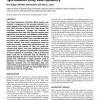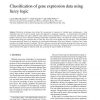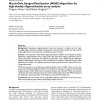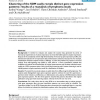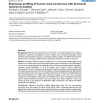NAR
2002
13 years 11 months ago
2002
The prediction of operons, the smallest unit of transcription in prokaryotes, is the first step towards reconstruction of a regulatory network at the whole genome level. Sequence ...
NAR
2002
13 years 11 months ago
2002
The Gene Expression Omnibus (GEO) project was initiated in response to the growing demand for a public repository for high-throughput gene expression data. GEO provides a flexible...
JIFS
2002
13 years 11 months ago
2002
Microarray technologies have allowed the measurement of expression of multiple genes simultaneously. Gene expression levels can be used to classify tissues into diagnostic or progn...
JCB
2000
13 years 11 months ago
2000
Although two-color uorescent DNA microarrays are now standard equipment in many molecular biology laboratories, methods for identifying differentially expressed genes in microarra...
BMCBI
2002
13 years 11 months ago
2002
Background: High-density oligonucleotide arrays have become a valuable tool for highthroughput gene expression profiling. Increasing the array information density and improving th...
BMCBI
2002
13 years 11 months ago
2002
Background: Affymetrix microarrays are used by many laboratories to generate gene expression
BMCBI
2002
13 years 11 months ago
2002
Background: A method to evaluate and analyze the massive data generated by series of microarray experiments is of utmost importance to reveal the hidden patterns of gene expressio...
BMCBI
2002
13 years 11 months ago
2002
Background: Molecular characterization has contributed to the understanding of the inception, progression, treatment and prognosis of cancer. Nucleic acid array-based technologies...
BMCBI
2004
13 years 11 months ago
2004
Background: An important challenge for transcript counting methods such as Serial Analysis of Gene Expression (SAGE), "Digital Northern" or Massively Parallel Signature ...
BMCBI
2004
13 years 11 months ago
2004
Background: cDNA microarrays are a powerful means to screen for biologically relevant gene expression changes, but are often limited by their ability to detect small changes accur...

